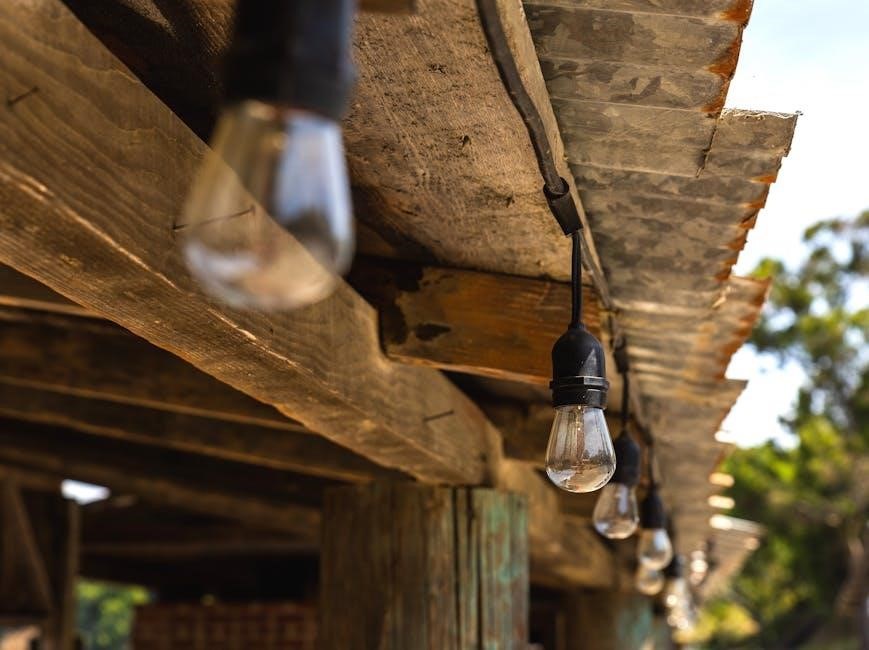A home wiring diagram is a visual guide that simplifies electrical systems, showing connections between components like switches, outlets, and circuits․ It ensures safety, compliance, and efficient installations․
1․1 What is a Home Wiring Diagram?
A home wiring diagram is a detailed visual representation of a house’s electrical system, illustrating how wires, circuits, and components are connected․ It simplifies complex electrical systems by showing the layout of outlets, switches, lights, and appliances․ The diagram serves as a blueprint for electricians and DIY enthusiasts, ensuring safe and correct installations․ It typically includes symbols for devices like circuit breakers, fuses, and grounding systems․ By following the diagram, users can identify where wires should be routed, how connections are made, and how power flows through the system․ This essential tool helps prevent errors, ensures compliance with electrical codes, and makes troubleshooting easier․ It is often provided in PDF format for easy reference and printing․
1․2 Importance of Wiring Diagrams for Safety and Compliance

Wiring diagrams are crucial for ensuring safety and compliance in home electrical systems․ They provide a clear visual representation of the electrical layout, helping to prevent hazards like shocks, fires, and short circuits․ By following a diagram, homeowners and electricians can install and repair systems correctly, adhering to national and local electrical codes, such as the National Electrical Code (NEC) and NFPA standards․ Compliance ensures the system operates safely and efficiently, protecting people and property․ Diagrams also serve as a reference for inspections and troubleshooting, making it easier to identify and resolve issues․ Using a wiring diagram in PDF format ensures accuracy and accessibility, helping to avoid costly mistakes and legal penalties․ It’s a vital tool for maintaining electrical safety and integrity in any home․
Understanding Home Wiring Diagrams
A home wiring diagram is a visual tool that simplifies complex electrical systems․ It shows how components like wires, switches, and outlets connect, making it easier to understand and work with home electrical systems safely and effectively․
2․1 Components of a Wiring Diagram
A wiring diagram consists of standardized symbols, lines, and labels that represent electrical components․ Symbols depict devices like switches, outlets, and circuits, while lines show connections between them․ Labels provide details such as wire colors, voltage, and component IDs․ Color coding is often used to differentiate live, neutral, and ground wires․ A key or legend is included to explain symbols, ensuring clarity․ These components work together to create a clear, visual representation of an electrical system, making it easier to install, troubleshoot, and maintain wiring safely and efficiently․ Understanding these elements is crucial for interpreting and applying the diagram correctly in DIY or professional projects․
2․2 How to Read a Wiring Diagram
Reading a wiring diagram involves understanding its symbols, lines, and labels․ Start by identifying the legend, which explains the meaning of each symbol․ Locate the main power source and follow the flow of connections․ Lines represent wires, while colors often indicate live, neutral, or ground wires․ Labels on wires and components provide details like voltage or function․ Focus on one circuit at a time to avoid confusion․ Trace connections from switches to outlets or lights, ensuring all paths are clear․ Use the diagram to verify proper connections and identify potential issues․ Cross-reference with local electrical codes and safety guidelines․ By systematically analyzing the diagram, you can accurately interpret and apply the wiring layout for safe and successful installations or repairs․


Safety Considerations in Home Wiring
Ensure electrical safety by following codes and best practices․ Turn off power before starting work, use GFCI-protected outlets in wet areas, and avoid overloaded circuits to prevent hazards․

3․1 Essential Safety Tips for DIY Wiring Projects
Always turn off the power at the main electrical panel before starting work․ Use a non-contact voltage tester to confirm no electricity flows․ Install GFCI outlets in wet areas like kitchens and bathrooms to prevent shocks․ Avoid overloaded circuits by ensuring proper wire sizing․ Grounding systems are critical for safety—never bypass them․ Secure wires tightly in walls and ceilings to prevent damage․ Follow local electrical codes strictly and consult professionals if unsure․ Keep work areas clean and well-lit, and use insulated tools to reduce accident risks․ Properly label circuits and components for future reference․ Remember, safety should never be compromised for convenience or cost․

3․2 Common Mistakes to Avoid in Home Wiring
One of the most common mistakes is using incorrect wire sizes, which can lead to overheating or fire hazards․ Improper connections, such as loose or exposed wires, can cause short circuits․ Many DIYers overlook grounding systems, which are essential for safety․ Ignoring local electrical codes can result in legal issues or dangerous installations․ Overloading circuits with too many devices is another frequent error, risking electrical failures․ Additionally, some individuals skip testing circuits before use, potentially leading to unnoticed faults․ Always ensure wires are securely fastened in walls and ceilings to prevent damage․ Mixing high and low voltage systems without proper separation can also be dangerous․ Correcting these mistakes requires attention to detail and adherence to safety guidelines․

DIY Home Wiring Projects
DIY home wiring projects simplify installations with detailed diagrams and step-by-step guides, ensuring safety and compliance for enthusiasts and homeowners alike for various electrical tasks․
4․1 Step-by-Step Guide to Basic Wiring
A step-by-step guide to basic wiring provides clear instructions for installing electrical components safely․ Start by identifying the main power source and ensure all circuits are turned off using a voltage tester․ Next, plan the layout of wires and outlets based on the wiring diagram․ Install junction boxes and run insulated wires through walls or along surfaces․ Connect switches, outlets, and lighting fixtures according to the diagram, ensuring all connections are secure․ Finally, test each circuit to confirm proper functionality before restoring power․ Always follow safety guidelines and local electrical codes to avoid hazards and ensure compliance․
4․2 Troubleshooting Common Home Wiring Issues
Troubleshooting home wiring issues requires identifying symptoms like flickering lights, tripped circuit breakers, or non-functional outlets․ Start by turning off the main power supply and using a voltage tester to ensure safety․ Check for loose connections, damaged wires, or overloaded circuits․ Consult your wiring diagram to trace the circuit and locate the fault․ Common issues include faulty switches, blown fuses, or ground fault interruptions․ For persistent problems, use a multimeter to test wire conductivity and voltage levels․ Addressing these issues promptly prevents electrical hazards and ensures reliable power distribution․ Always follow safety guidelines and consider professional help if unsure․
Room-Specific Wiring Guides
Room-specific wiring guides provide detailed diagrams and instructions for each area of your home, ensuring safe and efficient electrical installations tailored to your needs․

5․1 Kitchen Electrical Wiring

Kitchen electrical wiring requires careful planning due to high-power appliances and safety considerations․ Home wiring diagrams provide detailed layouts for outlets, switches, and circuits․ They ensure compliance with local codes, such as GFCI protection for outlets near water sources․ Diagrams visualize connections for appliances like ovens, microwaves, and dishwashers, highlighting dedicated circuits to prevent overloads․ Grounding systems are emphasized to safeguard against electrical shocks․ Step-by-step guides in PDF formats offer clear instructions for installations and repairs․ These resources are essential for DIY projects, ensuring safety and efficiency in kitchen electrical systems․ Proper wiring prevents hazards and guarantees reliable performance for all appliances․
5․2 Bathroom Electrical Wiring
Bathroom electrical wiring involves specific safety measures to prevent hazards․ Home wiring diagrams outline GFCI-protected outlets near water sources and proper lighting installations․ They ensure compliance with local codes, reducing shock risks․ Diagrams detail connections for exhaust fans and heated mirrors, emphasizing dedicated circuits․ Grounding systems are critical for safety․ Step-by-step guides in PDF formats aid DIY projects, ensuring correct installations․ These resources help avoid common mistakes, like inadequate ventilation or improper GFCI usage․ Proper wiring ensures reliability and safety in bathroom electrical systems, preventing potential hazards and ensuring compliance with safety standards․
5․3 Bedroom and Home Office Wiring
Bedroom and home office wiring requires careful planning to ensure functionality and safety․ Home wiring diagrams detail outlet placements for lamps and electronics, with dedicated circuits for heavy-use areas․ Lighting systems, including dimmers, are explained with clear connections․ Data ports and USB outlets are highlighted for modern home offices․ Safety measures include surge protection for sensitive devices․ Diagrams guide installations for ceiling fans and smart home devices․ Proper grounding and cable management are emphasized to prevent interference․ These guides help homeowners avoid common mistakes, ensuring reliable and efficient electrical systems tailored to personal needs․ With step-by-step instructions, users can confidently install or upgrade their bedroom and office wiring, ensuring safety and functionality․

5․4 Garage and Workshop Wiring
Garage and workshop wiring requires specialized planning due to high power demands and safety considerations․ Home wiring diagrams detail circuits for outlets, lighting, and heavy-duty appliances like air compressors․ Dedicated 20-amp circuits for tools and GFCI protection in damp areas are essential․ Wiring for task lighting and overhead fixtures is included, along with options for 240-volt circuits for larger equipment․ Safety tips emphasize proper grounding and surge protection․ Diagrams guide installations for sub panels and circuit breakers, ensuring reliable power distribution․ Clear instructions help avoid common mistakes, such as overloaded circuits or incorrect wire gauges․ These guides enable homeowners to create efficient, safe, and functional garage and workshop electrical systems tailored to their specific needs and projects․
